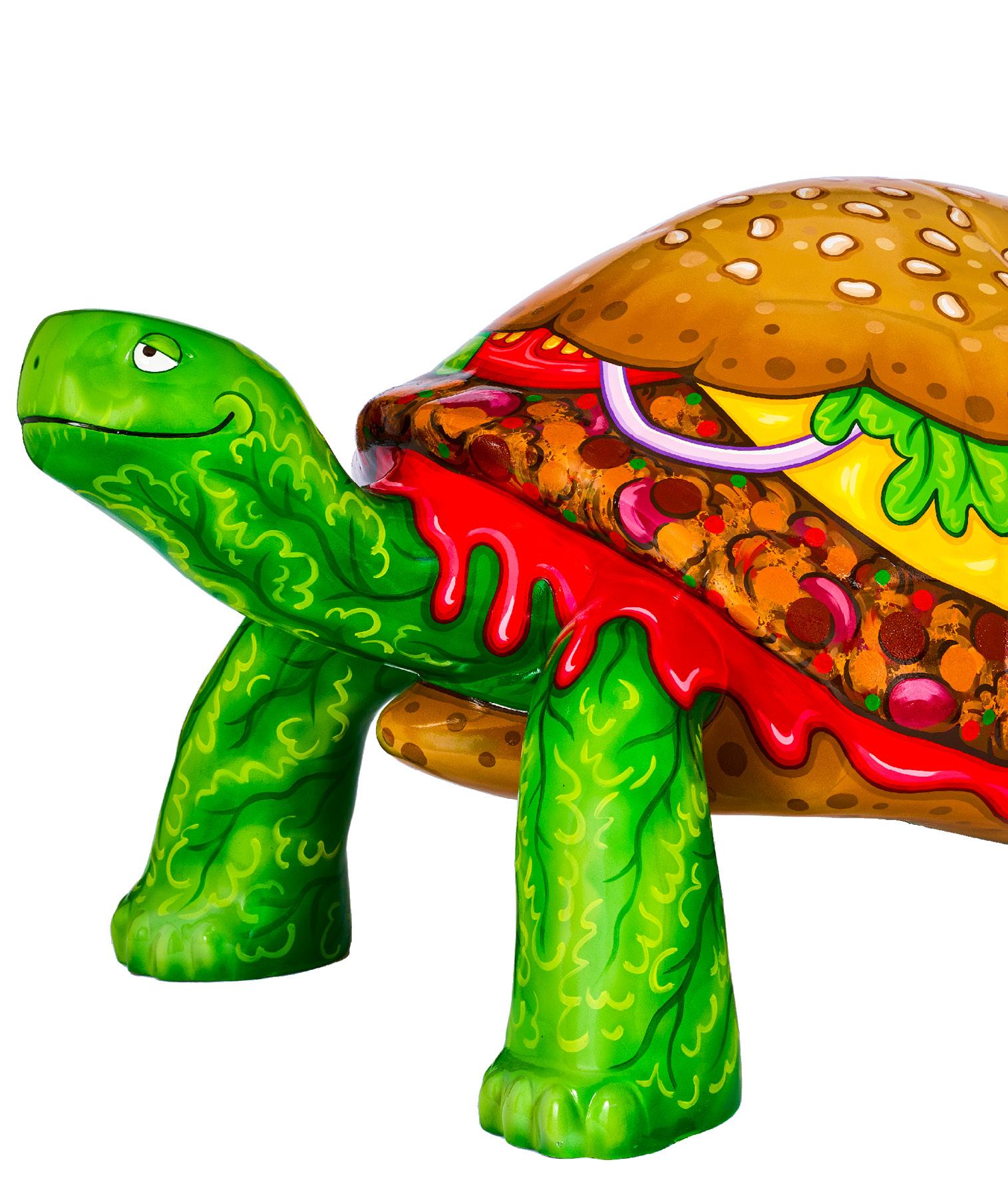WILD LIFE



Join a group of wildlife enthusiasts supporting Durrell’s vision of a wilder, healthier, more colourful world.
Set up by Gerald and Lee Durrell on the 25th anniversary of the Durrell Wildlife Conservation Trust to be true “guardians” of the Trust, the Durrell Gardiens are a committed group of supporters, passionate about conservation and making a difference. The Gardiens are ambassadors for Durrell and take pride in sharing our work with friends and acquaintances worldwide.
Gardiens receive invitations to bespoke events and behind-thescenes tours, and are among the first to gain insights into our work direct from the Jersey Zoo team and international conservationists. As a Gardien, you will also receive regular project updates and, together with the Durrell team, you will be part of the process in deciding where your collective gift is allocated.
Richard Prosser has been a passionate Durrell supporter for many years and took on the voluntary role of ‘Chef de Gardiens’ in October 2020. Richard would be delighted to hear from anyone who wants to find out more about joining as a Durrell Gardien.

Being a Gardien involves giving an annual gift of £1,500 to Durrell, enabling our mission of saving species from extinction, and directly supporting our zoo projects, which are vital to our vision of a wilder, healthier, more colourful world.
Please contact Richard on +44 7797 717344 or email him at richard@prosser.je

Joining as a Gardien brings you even closer to the work of Durrell, with exclusive opportunities to meet the expert team and experience our work first-hand.
Welcome to the summer edition of Wild Life, which reveals the impressive scope of activities undertaken by Durrell. From our zoo in Jersey to our field sites across the globe, our mission – saving species from extinction – is a multifaceted endeavour.
At the zoo we not only work with well-known species, like gorillas and flamingos but with small, more obscure creatures, such as the threatened beetles, snails and millepedes of Frégate Island in the Indian Ocean.
As well as breeding rare animals for conservation purposes, we ‘train’ the animals to cooperate in their own health care and management. Presenting a shoulder for an injection or readily stepping (or hopping or climbing) onto weighing scales is not stressful to the animals (and their keepers).
We also focus on people and their contribution to conservation. At the charity shop at Jersey Zoo, we urge our visitors to ‘reduce, reuse, rewild’. With our excellent partner, Jersey Overseas Aid, we help villagers in Madagascar develop more sustainable livelihoods.
You will hear from Rico, a graduate of our DESMAN course, who is doing wonderful work in the Seychelles, and from Noelli, who joined the Durrell team in Madagascar this year as Head of Species Conservation and Research. We learn that Juliette, who has been working with the rere turtle in Madagascar for many years, has won a prestigious grant from the Whitley Fund for Nature, which will allow her to expand the recovery programme for this species. Coincidentally, Jersey Zoo has bred the rere for the first time this year (only the second successful breeding in Europe).
In more zoo news, we have welcomed four huge Aldabra tortoises to Jersey Zoo, one of whom is Twiggy, who lived here in the 1960s. They tell the fascinating story of our efforts to rewild Round Island, where the native giant tortoises became extinct in the 1700s.
We hope that Twiggy and her cohort inspire you to follow the Tortoise Takeover trail this summer in Jersey. Fifty enormous models of tortoises, beautifully painted by artists from all over the world, will be placed around the island to celebrate this fascinating group of animals and Durrell’s role in their conservation.
DR LEE DURRELL HONORARY DIRECTORIt is important to us that we keep you informed about our work, and the difference we are making to the many species, habitats and local communities with which we work. If your household has received more than one copy of Wild Life and you would like to discuss your mailing preferences going forward, please don’t hesitate to contact a member of our Supporter Care team on supportercare@durrell.org or (0)1534 860111
If you’d like to hear from us regularly subscribe to our email newsletter at www.durrell.org
DURRELL WILDLIFE CONSERVATION TRUST
Les Augres Manor, La Profonde Rue, Trinity, Jersey, JE3 5BP, Channel Islands
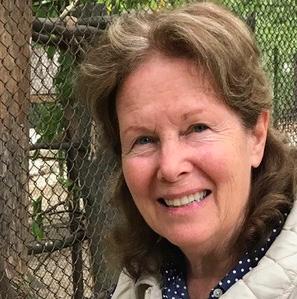
I have some amazing news to share with you, that is truly transformational for Durrell, and I wanted you to be amongst the first to hear it.
Thanks to the incredible generosity of a family foundation, I am delighted to announce that Durrell is about to launch a new UK rewilding project. This is a unique and exciting opportunity to restore a large estate in Scotland to a wild and diverse landscape.
Our ‘Rewild our World’ strategy recognised that nature on our doorstep is some of the most denuded on Earth. In this strategy we committed to ‘a landscape-scale rewilding project to restore wild habitats and ecological processes, using our skills to bring back missing and iconic wildlife, and ensuring local people will benefit.’ With this in mind, we have been working closely with the family foundation, who share our 100-year vision for this large-scale rewilding project. As a result, thanks to their amazing philanthropic support, we are now the leaseholders of the Dalnacardoch estate in Perthshire.
For decades, the land, which sits within the Cairngorms National Park, has been used as a sporting estate and as a result is severely degraded. Our long-term vision for this project is to breathe life back into this landscape by restoring habitats and ecological processes, recovering iconic missing species and rebuilding a strong, emotional connection between people and the environment.

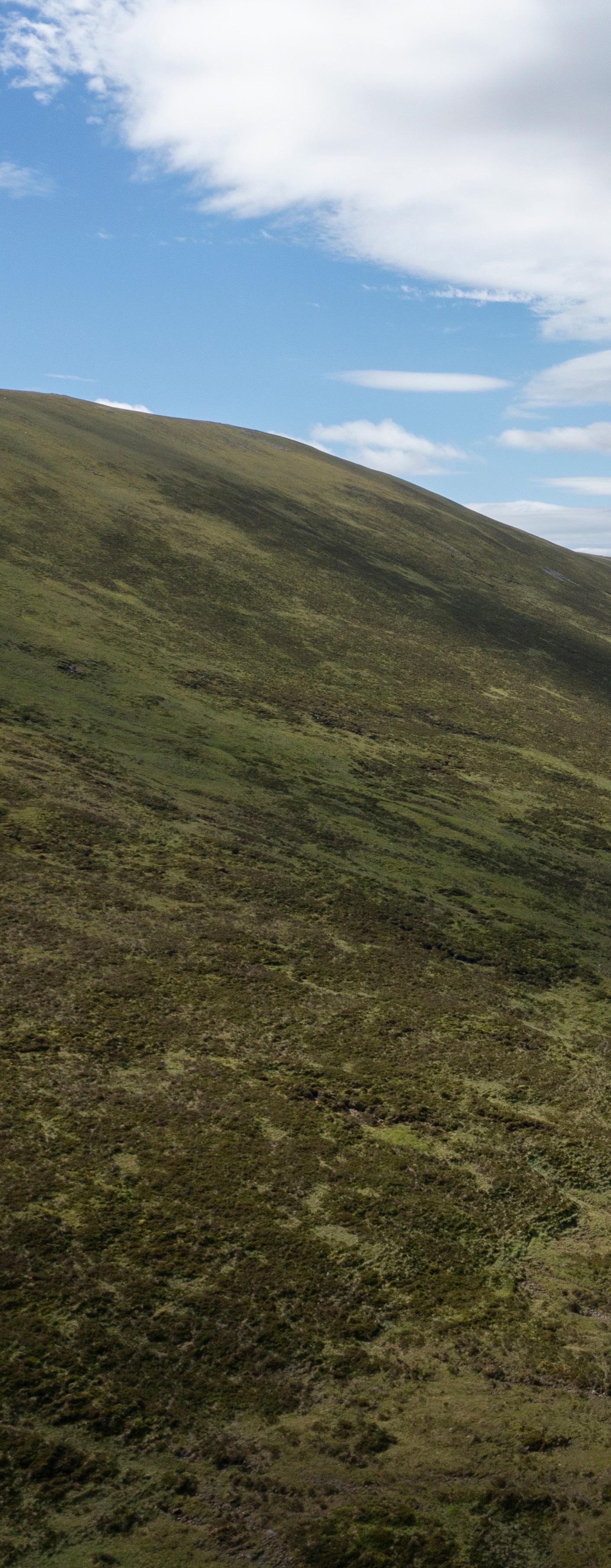
This marks a real step change for Durrell and is an incredible opportunity to apply our proven techniques in saving species and reviving ecosystems, as well as to demonstrate conservation in action, closer to home.
I hope you enjoy and support this incredible journey on which we are about to embark.
Dr Lesley Dickie

In electrical circuits, grounding or earthing protects people from receiving a shock and coming to harm. When electricians ‘earth’ something they are thinking ahead, about the hazards caused by static build up or when surges, such as lightning strikes, occur with little warning.
Throughout our work lives and in our homes, we consider all kinds of health and safety, not just that of electrical systems. What is the best way to prevent harm? We wear seatbelts in the car, have speed limits, buildings have fire extinguishers and alarms. We all take hundreds of little actions every day that perhaps we are not even consciously aware of. Perhaps then we should better consider the way we treat planet Earth and think about how we can better ‘earth’ ourselves if we are to have a sustainable future?
Nature is not passive, it’s an enormous active system, that will react when the finely balanced processes that have evolved over millennia are under assault. We are all aware that the collective
actions of humans are the cause of that assault and the time to act is now. It’s been ‘now’ for quite a while, but here’s why it’s not too late…yet.
What we are seeing in nature right now is the static build-up. The continued diminution of species and ecosystems, removal of unique habitats and dwindling animal populations. We need to prevent the static reaching such an overwhelming scale where it causes the the sudden catastrophe, the lightning strike if you will. Whilst we are used to seeing worrying reports of declines, this slow decline is only part of the picture. Whilst it’s in this phase there is still hope. However, depressing though the facts can be, we must not give up. We must not neglect our planet until there is nothing else for it to do but react violently with a sudden ecosystem collapse. By sudden we mean over decades, but this is a blink in the eye of our Earth and within the time scale of our human lives.
Time is a funny thing. Sometimes it feels fast. Sometimes slow. Certainly, as we age, our perception of time changes and the years
seemingly go by far quicker in our minds than when we were young. We think of ourselves as a longlived species, and comparatively we are. However, there are other species out there, with slow growing generations, who experience this planet far longer than we do. We know so little about species such as the Greenland shark, which unhurriedly navigates the icy cold depths of the Arctic Ocean. It has the longest known lifespan of any vertebrate species, living for as long as over 500 years. It’s thought this species does not even reach sexual maturity until 150 years old. A giant of its kind, these sharks can be up to 23ft long, with the lowest swim speed of any fish in relation to its size. What do these sharks see over five centuries, and do we know how each generation of humans is impacting the same giant fish over and over again?
On land we also have giant reptiles that are slow growing, slow to reach sexual maturity and whose lifespans far outlive our own. These are of course the giant tortoises of the Galapagos and the Indian Ocean (the Aldabra Atoll and Seychelles). Whilst Jersey Zoo has housed young Galapagos tortoises for a few years, the more recent arrival of the four Aldabra tortoises, really demonstrate quite how big these animals can be. You can learn more about these four giants in the article on 10. The world’s oldest tortoise currently known is Jonathan, another Seychelles giant, who lives on St Helena and is approaching his 200th birthday. Our new giant tortoise house is proving popular with visitors as they gaze at these slow-moving goliaths. I may be imagining it, but there is a lot of experience to see in an old tortoise’s eyes and there is great worth in us as humans slowing down, even for a moment, to commune with them and take stock of the span of our own lives.
This summer we are experiencing a much bigger communing with tortoises’ experience with the 50 giant sculptures of our Tortoise Takeover trail, placed all over the island. They joined the 65 ‘mini giants’ of the schools and community group tortoises that made their debut in June in multiple indoor spaces. We hope that islanders and visitors alike will have a wonderful time in finding them all, and the happiness we experienced of the 2019 Go Wild Gorillas trail takes flight again for all age groups of humans.
It’s in finding all the tortoise sculptures that I want to return to the theme of earthing ourselves. Take a moment when out in the island, marvelling at the imagination of the artists who have bought the trail to life with their unique and colourful designs. Stop, ponder and think of our responsibility to the planet and our connection to all the species that inhabit it. We may not live as long as a Greenland shark, or even a tortoise, but our potential for negative impact on our world is magnitudes greater. The converse is however also true. Walk a slow mile in a tortoise’s path and think deeply about how your impact could help save our nature instead of diminishing it. You will feel better for it and the tortoises will thank you.

Stop, ponder and think of our responsibility to the planet and our connection to all the species that inhabit itAldabra tortoise
Almost a year ago, the gorgeous golden Guernsey goats joined us at Jersey Zoo and quickly became visitor favourites! Elvis, Lily, Gypsy and Belle now have a brand-new luxury barn to match their celebrity status. The indoor area is well-ventilated, with a public viewing space and a keeper area to store their leads for regular walks around the zoo.

Six Critically Endangered Madagascar big-headed turtles, known as “rere” in Malagasy, were hatched at Jersey Zoo towards the end of last year. This is the first time Jersey Zoo, and only the second time a European zoo, has bred this species. Our experts are keeping a close eye on the turtles’ development behind the scenes, so visitors will not be able to spot them in their enclosure. Durrell has been working to protect this threatened species since 1998, and the knowledge gained from these hatchlings will be passed to our Malagasy colleagues, based at the turtle-breeding centre in Madagascar.


A coppery titi monkey arrived at Jersey Zoo earlier this year. Zaria is a six-year-old female from Banham Zoo in Norfolk. Her arrival was a delightful surprise to our resident male titi monkey, Teddy. Keepers said Teddy’s courtship was not the most subtle when they were first introduced, but he has since calmed down and she now approaches him. The pair are living together in the titi enclosure on the edge of the Tamarin Woods, with the hope that their relationship will continue to blossom as they explore their free-ranging habitat together.
Bats are seen by some as pests or disease-spreaders, but the winged mammals are largely misunderstood. One in five bat species is under threat, and conservationists are relying on changing attitudes to help save them. Durrell’s Zoo Research Manager, Eluned Price, and Laura Johnson from the University of Leeds, carried out research using a five-minute virtual fruit bat experience. They used videos and pictures of Jersey Zoo’s bats for the experience, which resulted in people using more positive descriptions for bats, such as “maternal” and “graceful” afterwards. Wider results also showed that Jersey Zoo guests who visited the Island Roost in person viewed bats more positively.


In preparation for the arrival of Linne’s two-toed sloths, Terry and Rio, in November 2022, Zooscapes designer Darren Norbert made them a new luxurious new home. Darren has previously applied his outstanding skills to a wide variety of design challenges, including the sets of famous TV shows. The sloths’ one-of-a-kind enclosure, based in the Cloud Forest at Jersey Zoo, includes underfloor heating and Darren’s feature tree in the middle. The tree has builtin hoops for rope bridges and realistic rough bark to mimic trees found in South America.

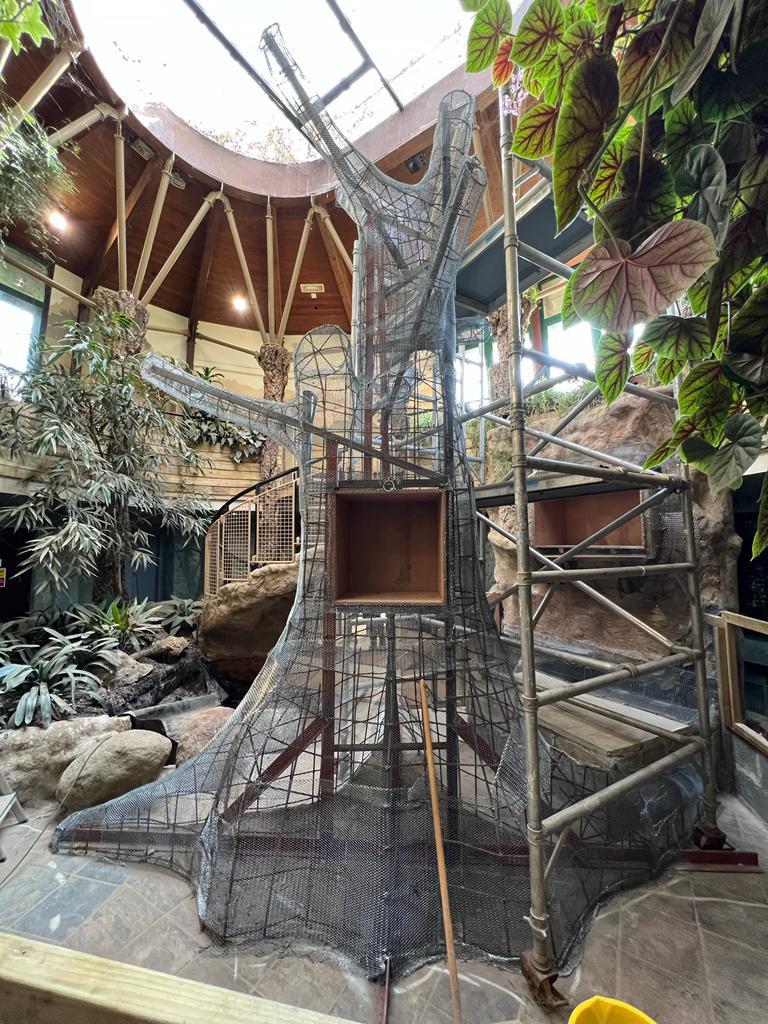

Here’s the tree’s transformation, from initial sketches to luxurious sloth re-tree-t.
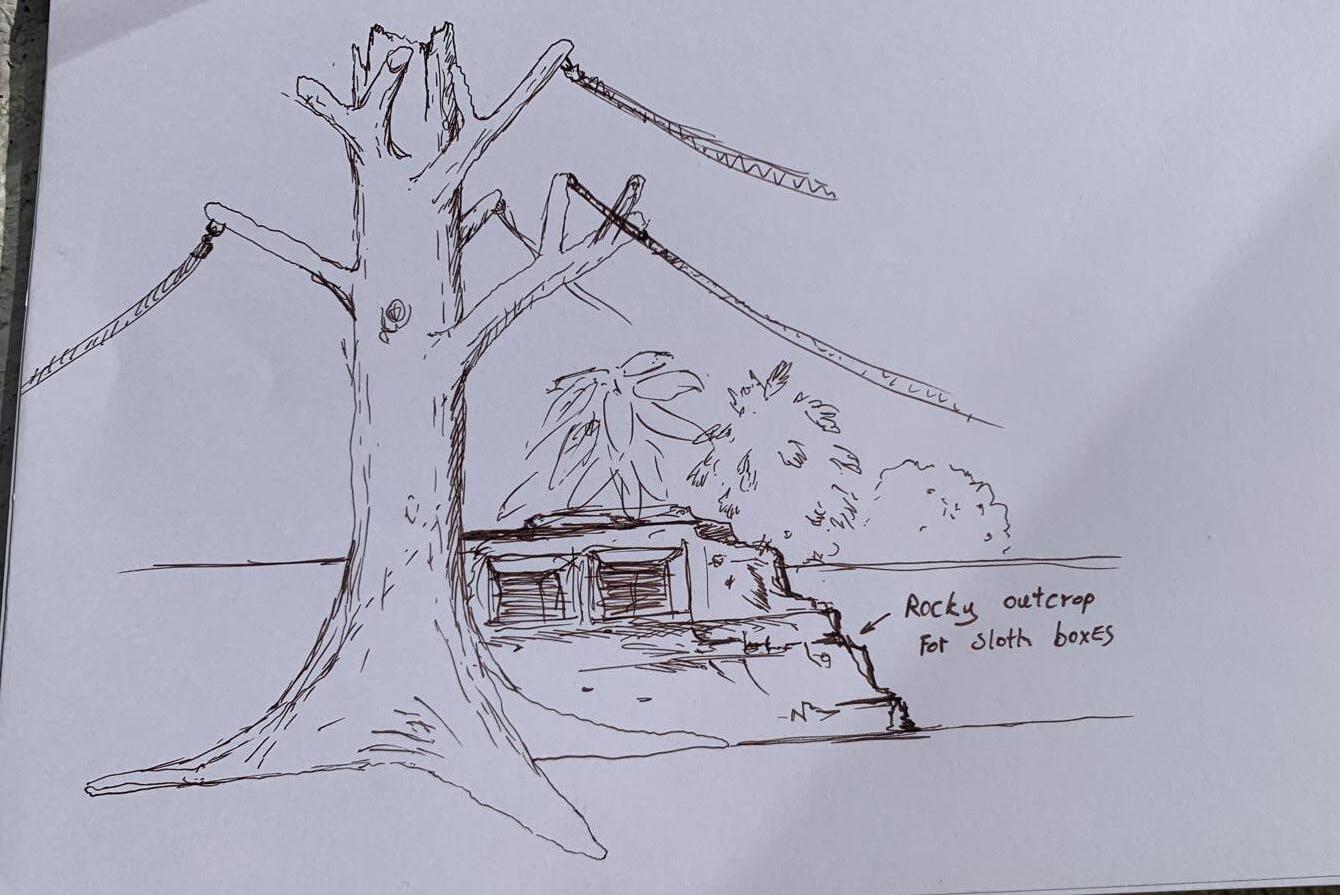
Rere Turtle Conservation Manager, Juliette Velosoa, has won a Continuation Funding grant from the Whitley Fund for Nature. Juliette has led the recovery for the Madagascar big-headed turtle, or “rere” as it’s known in Malagasy, with Durrell since 1998. She won the 2016 Whitley Award and has been given an additional £70,000 over two years to help scale up the work to protect this critically endangered species in Madagascar. Adult turtles and their eggs face threats such as being hunted for food and caught as bycatch via illegal fishing practices. Loss of their wetland habitat, which is damaged by overexploitation for resources and invasive plant species, is also a major concern.


Durrell carries out reforestation and restoration across five sites in Madagascar. In 2022, we helped to restore over 300 hectares of land and planted over 442,000 seedlings. The country has one of the highest deforestation rates globally and has lost more than 53% of its forest since 1953. This loss of habitat and ecosystem services, such as water purification, protection from cyclones, and capturing carbon, severely affects local communities who rely on natural resources. Under the African Forest Landscape Restoration Initiative, Madagascar has pledged to restore 4 million hectares of forest landscapes by 2030.

Since 2010, we’ve been working as part of Birds On The Edge to reintroduce redbilled choughs to Jersey where they had gone locally extinct. The current population of 43 birds comprises individuals released from captivity and their wild-hatched offspring. The birds are ringed to help us to identify them, which is particularly handy when spotted elsewhere. One was seen in France and another two have been seen making trips to Sark and Guernsey. We are currently monitoring this population with daily observations and nest checks, and plan to study nesting success with Durrell Institute of Conservation and Ecology at the University of Kent.

Amy Bompas, our Rewild Carbon Manager, visited the Atlantic Forest in March to see the achievements of this programme in person. Thanks to the 35 businesses that have chosen to balance their carbon emissions with Rewild Carbon over our first 18 months, we have replanted more than 100 hectares of forest with over 180,000 trees. Jobs at the tree nurseries and planting saplings provide stable income for many local families and support surrounding communities, as well as restoring the home of many of Brazil’s most iconic species. Whilst in the Atlantic Forest, Amy saw black lion tamarins and tapir footprints, signs of just some of the wildlife the restored forest will support.
To find out more about Rewild Carbon visit durrell.org/rewildcarbon
Last year, 120 vulnerable lesser night geckos were moved from the Mauritian islet Gunner’s Quoin to Round Island by Durrell and our partners. Over the past 400 years, reptiles in Mauritius have been severely impacted by invasive species and habitat loss. Prior to conservation intervention, Round Island was invaded by goats and rabbits, which stripped the island of vegetation. This exposed small species, like the lesser night gecko, to predators and caused multiple extinction events. The small 6cm-long geckos were moved in efforts to rebuild populations and reduce the risk of further extinction.


Native to the Aldabra atoll in the Seychelles, Aldabra giant tortoises are one of the largest species of tortoise in the world.
Giant tortoises were once found across many of the Western Indian Ocean islands like the Seychelles, Mauritius and Madagascar. Extensive hunting for their meat and oils, and predation of tortoise eggs and hatchlings by invasive rats, cats and dogs, led to many giant tortoise populations being wiped out. With so many giant tortoise species becoming extinct, the future looked worrying for the Aldabra species. In response in 1874, Charles Darwin and other notable naturalists petitioned the Mauritius and Seychelles Governor to take action to prevent the extinction of the Aldabra giant tortoise. In 1875,it became one of the world’s first species to be protected by law.

LIFESPAN Over 150 years
WEIGHT Males can reach 250kg; Females can reach 160kg
SIZE Male shell length can reach 1.2m; Female shell length can reach 0.9 m



DIET Grasses, leaves and fruit
GEOGRAPHIC RANGE
Aldabra Atoll, Seychelles

The new state-of-the-art Tortoise Tunnel at Jersey Zoo opened at the end of March and is home to four Aldabra giant tortoises: Helen, Mike, Biggy and Twiggy.



They moved here from Bristol Zoo at the end of 2022 and spent a few months settling into their new enclosure before going on show (you can read more about how we transport animals on 25). The Tortoise Tunnel is equipped with an impressive temperature control system and high-power UV lights to help simulate the climate of their wild counterparts. You can find Tortoise Tunnel next to Butterfly Kaleidoscope and our Golden Guernsey goats.
AGE 41 FAVOURITE FOOD Celery
WEIGHT Approximately 114kg
Helen is the second smallest of the four tortoises but is by far the most confident and curious of the group.
AGE 24 FAVOURITE FOOD Flowers
WEIGHT Approximately 134kg
Mike is the second largest of the four and has the spikiest shell. Keepers say he’s shy but very friendly once he gets to know you.
AGE Between 60-70 FAVOURITE FOOD Freshly-cut foliage
WEIGHT Over 200kg
Biggy is the largest of the group and is a gentle giant who loves to snooze in the enclosure pool.
AGE Between 60-70 FAVOURITE FOOD Red pepper
WEIGHT Approximately 79kg
Twiggy is the smallest of the group. She lived at Jersey Zoo in the 1960s and is a returning resident. She’s strong-willed and stubborn.
Mauritius once had two species of endemic giant tortoises; the domed and the saddlebacked. By the 1730s, Mauritius giant tortoises were extinct on the mainland. The last Mauritius giant tortoise on Round Island was recorded in 1844, and they were thought to become extinct soon after.
After Durrell joined the Mauritian Wildlife Foundation, the Government of Mauritius and other conservation organisations to restore the islands’ ecosystems, it became apparent that the island habitats needed giant tortoises. They act as ecosystem engineers and are often the primary grazers and seed dispersers of island plants. On islands where giant tortoises were once present,

much of the vegetation evolved alongside them and relies on tortoises to survive. Trials were carried out using tortoises in enclosed areas on Mauritian islands to monitor their impact on the habitat. As a result, the Aldabra tortoise was chosen as an efficient ecological replacement for the extinct Mauritius giant tortoise.
Aldabra giant tortoises are helping to restore Round Island by enhancing the survival and distribution of threatened plant species, controlling non-Mauritian plants and creating habitats for many other threatened Mauritian animals.
Frégate is a wildlife-rich island in the Seychelles, just north of Madagascar, which boasts a unique ecosystem. With highly fertile soil, the island is an ideal home for the “Frégate Little Five”, made up of the Seychelles giant millipede, Frégate Island giant tenebrionid beetle, Frégate Island enid snail, black giant scorpion, and the Seychelles whip scorpion. Jersey Zoo has three of these fantastic species on site and, over the past few months, keepers have been strengthening their husbandry techniques for these unique invertebrates. Their efforts have been rewarded with the tiny pitter-patter of multiple sets of feet!

One of the largest millipedes in the world, the endangered Seychelles giant millipede can reach up to an impressive 15cm long. Essential ecosystem engineers, they contribute to soil formation by breaking down plant litter. Jersey Zoo’s millipedes are part of a European Association for Zoos and Aquarium Ex-Situ Breeding Programme (EEP) and, for the first time at the zoo, the millipedes have hatched larvae.

The Frégate Island giant tenebrionid beetle is one of the largest beetles in the western Indian Ocean. The wild population is now thought to only be found on Frégate, where it mainly lives on the Sandragon tree. Director of Operations at Jersey Zoo, Graeme Dick, is the EEP Studbook Keeper for these vulnerable beetles. Excitingly, the zoo has welcomed multiple larvae and our first fully developed adult beetles.
The endangered Frégate Island enid snail is an endemic species which occupies a single, continuous range of only two square kilometres on the island. Another first for the zoo, the team have been doing an incredible job with this species, breeding several generations of offspring!

DON’ t FORGET tO GRAB YOUR La BCOAT AN d M i CROSCOPE
We often focus on harmful bacteria, but there are lots of ‘good’ bacteria too.
Countless harmless bacteria live inside our bodies. They help us by taking up space that might otherwise be used by harmful bacteria. Without them, harmful bacteria can multiply out of control, causing illness.
Other bacteria are useful in other ways. Some produce oxygen. Some even produce artificial insulin – helping people with type 1 diabetes live healthy lives.
Cyanobacteri
MICROBE TYPE Bacteria
You only exist because these oxygen-producing bacteria do!
Once upon a time, our planet had no oxygen. Then, about 2.7 billion years ago, long before plants existed, cyanobacteria developed. They produced vast quantities of oxygen. Without their work, life as we know it could not have emerged.

Like plants, cyanobacteria contain a green substance called chlorophyll. This substance performs photosynthesis – the same oxygen-producing process that plants use. Unlike plants, however, cyanobacteria can often survive in some extremely harsh environments. They have been found growing under metres of ice, and in extremely hot springs. They are true survivors.
Baker’s yeast
MICROBE TYPE Fungus

This microbe makes bread and beer.
Yeast cells can turn sugar into alcohol and bubbles of gas. The process gives the yeast cells energy and gives us some in-demand substances. The gas bubbles make bread light and fluffy. Yeast’s ability to produce alcohol, meanwhile, makes it essential for beer and wine makers.
Yeast is a type of fungus. Each individual yeast is made of just a single cell. Those cells can reproduce quickly, however, by splitting themselves in two.
Not all bread is made using yeast. Sourdough is made using other microbes, which produce its distinct flavour. Either way, sandwiches would just not be possible without microbes!
Amongst the thousands of bacteria species that exist, some can make us sick.
Together with viruses and other harmful microbes, disease-causing bacteria are called ‘pathogens’. They include Salmonella (a common cause of food poisoning), and Streptococcus (a common cause of throat infections).
Harmful bacteria can reproduce rapidly inside our bodies. They produce toxins (poisons) that damage our body tissues and make us feel ill.
MICROBE TYPE Bacteria
Avoid this microbe like the plague - because it is the plague!
Yersinia pestis is a type of bacteria carried by some fleas. The bacteria infects humans when those fleas bite us. It can cause three potentially deadly forms of plague. Thankfully, these infections are now rare and can be treated by antibiotic medicines.
In medieval times, plague outbreaks killed millions of people across Europe. These terrifying outbreaks devastated whole communities and countries. An outbreak in 1665 killed one in every five Londoners. Almost half the population of Colchester, another English city, were killed. Microbes might be tiny, but they can have a massive impact on civilisation.

MICROBE TYPE Fungus
This little microbe is causing problems for the world’s frogs.
Frogs breathe through their skin. When this fungus infects a frog it thickens their skin, causing breathing problems and leads to cardiac arrest. Many frog species are now in serious trouble.
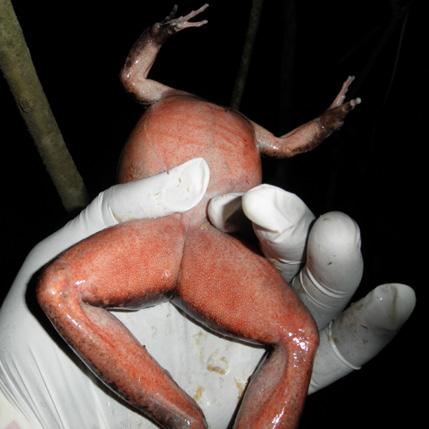
One of those species is the mountain chicken frog, from Montserrat and Dominica. When the fungus reached those Caribbean islands, the frogs were almost completely wiped out. Thankfully, we had a ‘back up’ population here at Jersey Zoo. We’re starting to return them to Montserrat – but must still protect their health.
Heat appears to kill the fungus, so we’re providing artificiallyheated ponds for the reintroduced frogs. By bathing in the ponds, the frogs may be able to fight off the infection.
Tardigrades can be found everywhere on the planet, from the sea to the soil.
Most tardigrades are less than a millimetre long.
Tardigrades are amongst the planet’s smallest animals and are related to insects.
Tardigrades can survive for years without water, but humans can only last a few days.
Tardigrades can temperaturessurvive as low as –273°C, but need warmer temperatures to normally.function
“water bears” or “mosspiglets”
You can provide homes for tardigrades, simply by letting moss patches grow.
Which bacteria will be under your magnifying glass? Take inspiration from the ones in the petri dishes or invent your own.
Saving species from extinction in their natural habitat also means securing the futures of people who depend on the same land.
Global commercial interests, growing populations, and the effects of climate change have impacted how land is used at Durrell’s rewilding sites in Madagascar. Over time widescale deforestation as well as unsustainable agricultural and fishing practices have stripped the local environment of its resources, which has made it challenging for local people to provide for themselves and their families. This radically changing landscape has placed greater pressure on species than ever before.
In 2018, we launched our Enabling Change programme, generously funded by Jersey Overseas Aid (JOA). The five-year programme aimed to protect the habitats and futures of three Critically Endangered species; the ploughshare tortoise,
Madagascar pochard and Alaotran gentle lemur. The programme included working with over 14,000 people who lived alongside these species to help enhance their food security, financial resilience, and skills needed to maintain the natural resources.
The vision for the project was to create a programme, with the potential to transform the lives of over one million people affected by the creation of Protected Areas across Madagascar. A project that would increase individual wellbeing, freedom of choice, and reduce pressures on the natural environment.
In 2023, with continued support from JOA, we have launched our brand-new five-year programme in Madagascar. The programme is called VALIHA ; VAtsy Loharano lombonana HAmpandrosoana, meaning “Resources for the wellbeing of people and nature to achieve development” in Malagasy.

VALIHA will focus on five pillars each created to build on what was achieved through Enabling Change. These pillars are: improving food security, improving financial independence, strengthening locally led governance, enhancing community health, and restoring ecosystem services and reducing threats to species.
Under the new project, we will reach an additional 10,000 people across the Baly Bay, Sofia and Alaotra regions of Madagascar, the regions we supported with Enabling Change, whilst continuing to support the 14,000 initial people involved in Enabling Change.
In the first of our two updates on this programme, let’s look back at what we have achieved over the past five years through Enabling Change and what we have planned for VALIHA.
Our aim: Improving year-round food security, nutrition and household income via nature-friendly food production, whilst also contributing to biodiversity conservation.
We trained and resourced 3,829 farmers through their enrolment in Farmer Field Schools. This included improving their knowledge of environmentally friendly farming techniques, increasing their access to high value and climate resilient vegetable crops, and encouraging them to share their skills and learnings with each other. These farmers are now using sustainable and Climate Smart Agriculture techniques across over 50% of their land. In just four years or less, this has brought average yield increases of 30% to 40% for main crops such as rice and maize. It has also brought up to 80% yield increases for cash crops like potato and onion. The number of months that the communities have access to enough food to eat has increased from 10 to 12.
The farmers involved in Farmer Field Schools have also reported a 100% reduction in chemical pesticide and fertilizer use, reducing the harmful chemical run-off which affected surrounding waterways.
Our work will continue with the poorest households to secure access to sustainable sources of food, whilst also helping them contribute to ecosystem recovery.
Occasional training will be delivered at existing Farmer Field Schools. This includes supporting farmers in times of crisis, such as flooding or cyclones. This will mean they can maintain the progress they made by taking part in the Enabling Change project.
We will establish Farmer Field Schools in 18 new villages to support the roll out of conservation and climate-smart agriculture activities. We are aiming for this to cover an additional 1,500 hectares by 2027, bringing the total area cultivated under these techniques to 2,530 hectares .

Our aim: Help 100% of households in all 40 target communities get access to safe drinking water and reproductive health services, leading to increased participation in natural resource management and conservation activities by 2027.
Be sure to check out our next edition of Wild Life, to hear more about our work to strengthen locally led governance, enhance community health and restore ecosystem services and reduce threats to species.
We would like to thank Jersey Overseas Aid for enabling this ambitious and impactful project and are excited to see what will be achieved in the next five years. The nature of this conservation-livelihoods work is scalable and is necessary across our rewilding sites in both Madagascar and India. With your support, we can do even more. If you would like to aid our conservation livelihoods work, please contact Harriet on harriet.croome@durrell.org
Women in 20 villages across Alaotra, Baly Bay and Sofia now have access to quarterly reproductive health advice and family planning services. Previously these resources did not exist, so the availability, of these services, particularly in remote areas such as Baly Bay and Sofia, has truly been transformational.
Over 3,820 women have chosen to take up the services offered by Marie Stopes Madagascar through this project partnership. They have reported benefits to their health and the health of their children, their household finances and food availability.

Our partnership with Marie Stopes Madagascar to offer reproductive health advice and reversible family planning services will continue.
Community Health Volunteers from participating villages will be recruited to raise awareness of the services offered and details of the quarterly visits.
We will support the renovation and, in some cases, possibly build health centres across Alaotra, Baly Bay and Sofia. This includes ensuring they are suitably equipped.
Opportunities to provide safe drinking water through building wells or bore holes in strategic villages will be identified.
We will monitor the activities undertaken by women to study how natural resource governance and environmental protectionare impacted by this project.
Noeli leads the team that undertakes our research activities on the ground in Madagascar. In this interview, he tells us why he wanted to work in conservation and what he enjoys the most about working at Durrell.
What sparked your passion for wildlife?
I have always been fascinated by forests and the animals that inhabit them. When I was little, I believed that they were sacred and that great spirits that guard our country and its people lived in them. That belief I guess is still in me somewhere. When I was a child, I used to play with frogs and small insects, but as I grew up, all I heard about wildlife was overwhelming words like “decline”, “loss”, and “degradation”. From then, I knew that I wanted a career in environmental conservation.
Tell us about your role in Madagascar
I took on the role of Head of Species Conservation and Research in February 2023. I oversee our programme’s research activities, population surveys, monitoring programmes and reintroduction projects in Madagascar. I work with local and international collaborators and organisations to facilitate the delivery of all the research and conservation work under the programme.
What are your hopes for the future of the region? Habitat loss and poaching are still the biggest threats to our species. With the development of technology, we can use tools to make population surveys and threat monitoring easier. For example, we currently use drones to deter people from destroying the forest. The challenges are huge, but I believe every bit of progress will have a big impact in the end. I hope that we can revive and protect the threatened species in their natural habitats.
What have been your first impressions of Durrell? Durrell’s mission of “saving species from extinction” had a big impact on me. So many animal species are facing extinction in Madagascar, and I knew that I wanted to contribute to this mission. Durrell approaches conservation from so many angles. When I joined the team, I was very excited to discover that we work not only on the conservation of threatened species and habitats but also on improving community livelihoods. Having passionate people working towards the same goals is really motivating.
What do you hope to achieve in this role?
One of my goals is to apply what we learn from research to conserve species. I am passionate about having measurable impacts on conservation by establishing new monitoring techniques and methodologies. I want to make the most of the data we collect, to discuss it with other teams, and make decisions that will have tangible impacts on our conservation programmes.
What do you enjoy the most about your work, and what is the most challenging part?
It is exciting to work on many different areas, species and ecosystems. I feel so lucky to have the chance to work with some of the most threatened species in Madagascar. Being able to go to the field observing the animals in their habitats is also priceless. The most challenging part is translating research results into action plans, and determining to what extent the actions would benefit species conservation.

The science of animal behaviour explores how animals respond to their environment and interact with others. Understanding different behaviours and how to manage them is crucial for conservation, welfare and care.
Jersey Zoo has been working with an animal training and behaviouralist expert to help teach our animals behaviours that will benefit them. Nikki Morrison from Animal Training Toolkit has over two decades of experience working with animals across the globe, helping them to learn how to cooperate in their care voluntarily. It may sound like an unusual concept, but as Nikki explains, it is really quite simple!
What is behaviour management?
Behaviour management is as simple as helping animals associate positively with behaviours that can improve their welfare. It can be hugely beneficial for both animals and their keepers and can result in teaching animals to undertake certain behaviours, such as standing on scales for weight monitoring or asking them to enter a transport crate voluntarily. It’s not just asking an animal to act for a reward; it’s learning what motivates them to help shape and encourage behaviours for their benefit.
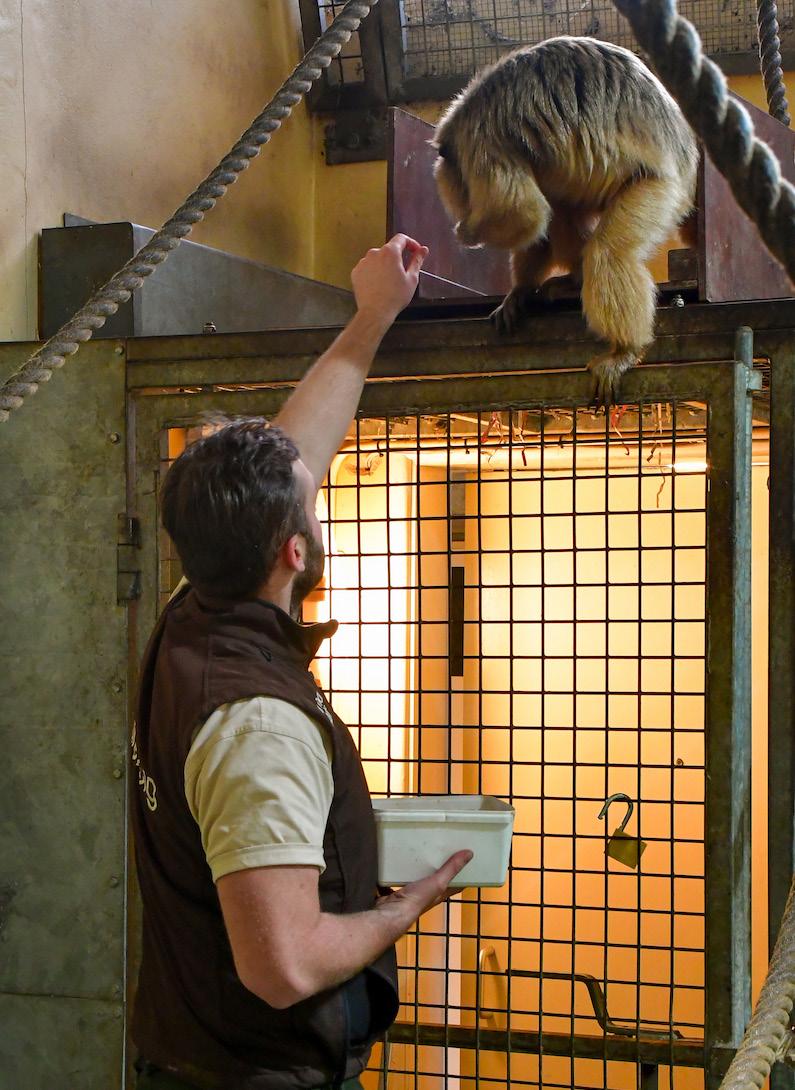

What training have you been doing at Jersey Zoo? The keepers already did plenty of excellent training, so my job was to review their objectives and priorities. I worked alongside the team to create structured approaches using modern, evidence-based standards and the leastintrusive ethical practices. One of the most important aims of this training was to familiarise the animals with the zoo’s vets. Animals can associate vets with negative
experiences, but involving vets in animal training without carrying out medical procedures helps to reduce this fear.
How do you train so many different species? Behaviour is a science. Like gravity, the concept of it always works the same, regardless of the species. I work closely with keepers, as they know each individual’s behaviours and preferred treats to reinforce the training. Being a pair of fresh eyes also helps me find required changes that keepers may miss, such as in the animal’s environment. For instance, if animals do not want to come indoors, I review the enclosure building for ways to make it more attractive to that specific species.
How did you get into this role? I got into animal training by pure luck! I’m originally from Glasgow city centre, so working with animals seemed like a pipedream. My nana is blind, so I grew up around guide dogs which sparked a passion for training and behaviour. After leaving college, I became a sea lion keeper, trainer, and presenter. A couple of years later, I was asked to work at a wildlife park in England. I started attending seminars and conferences, which made me realise that more than just parrots, sea lions, and birds of prey could be trained, so I produced a training programme for other animals at the park. I’ve since launched several animal training and behaviour programmes worldwide.
Nikki will continue to work with the keepers and vets at Jersey Zoo to enhance and further develop the animal training and behavioural management programmes. This will ensure we give all the animals the best care.

Captive breeding programmes provide safety-net populations for threatened species, preventing total extinction if wild populations are lost. The individuals we breed at Jersey Zoo are carefully selected to ensure genetic diversity. This matchmaking is no small task and requires researching potential candidates living at other zoos to make the eventual pairing as perfect as possible.
Zoological Information Management
Software (ZIMS) and studbooks provide data on animals at zoos and aquariums around the world, helping to identify suitable individuals. Genetics and family trees are considered to ensure the animals are the same sub-species and unrelated, with the goal of retaining 90% of gene diversity in that species’ captive population after 100 years of breeding. Additionally, we will assess the individual’s age, temperament, if they have bred before, and the current climate they live in.
Once we have chosen our perfect match, we will prepare to transport them to the zoo.
Moving animals requires meticulous planning and follows strict protocols. The crates that the animals travel in are species-specific and adhere to the International Air Transport Association


Live Animal Regulations. Wooden crates are often made in-house at the zoo, but external transporters typically provide more heavy-duty crates. The crate must allow its occupant to stand fully upright, lie down, and ensure the animal cannot access the crate’s exterior.
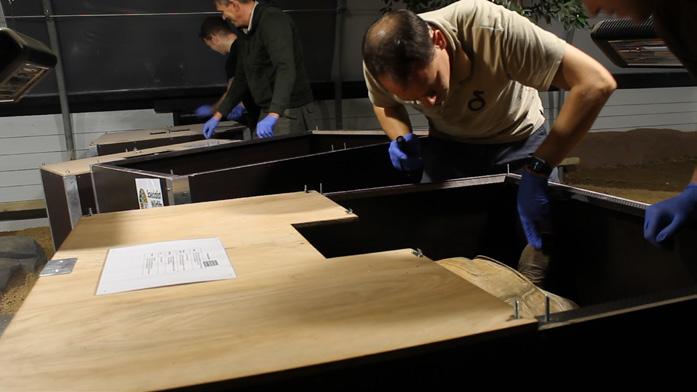
Preparation with the animal can include pre-move tests and training to familiarise them with the crate they will be travelling in. Carnivores, primates, and poisonous species require enhanced conditions such as specialised crates and minimal transit times to reduce the risks to the people transporting them. Sometimes, a keeper will accompany the animal to help ease the transition into their new home.
Last year, we welcomed the arrival of four Aldabra giant tortoises. Transporting them was no easy task, as the largest weighed over 200kg! A specialised animal transporter drove them from Bristol Zoo to Portsmouth, where they took the ferry the following day. Reptiles rely on an external heat source to maintain their body temperature, so their crates must be kept at around 20-25C degrees.

We regularly transport animals and have sent them around the globe, as far as Australia, South Africa, and South America, allowing the continuation of breeding programmes.
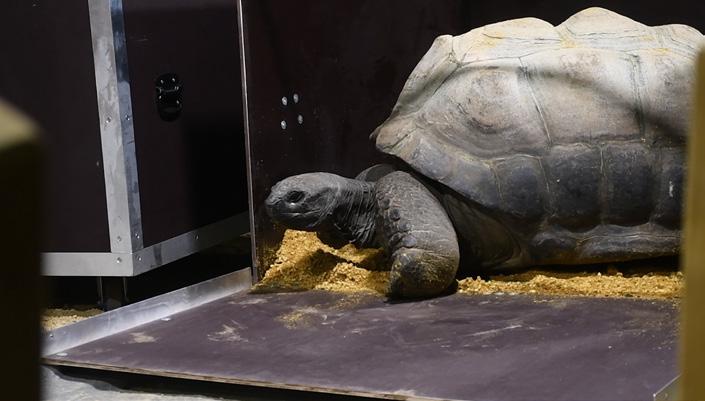

Thank you to everyone who has supported us over the past few months. We are so grateful to our fundraisers, members, volunteers and sponsors, and we hope some of the ways supporters are helping to save wildlife will also inspire you.
uniquely designed tortoise sculptures have taken over Jersey’s wild places, coastal vistas and urban hangouts as ambassadors for all the work that we undertake with reptiles across the globe. From the “tort-ally” inspirational, to the bright and bold and tortoises that focus on the wild world, see if you can spot all 50 large and 65 small sculptures across the island from 16 June – 31 August.

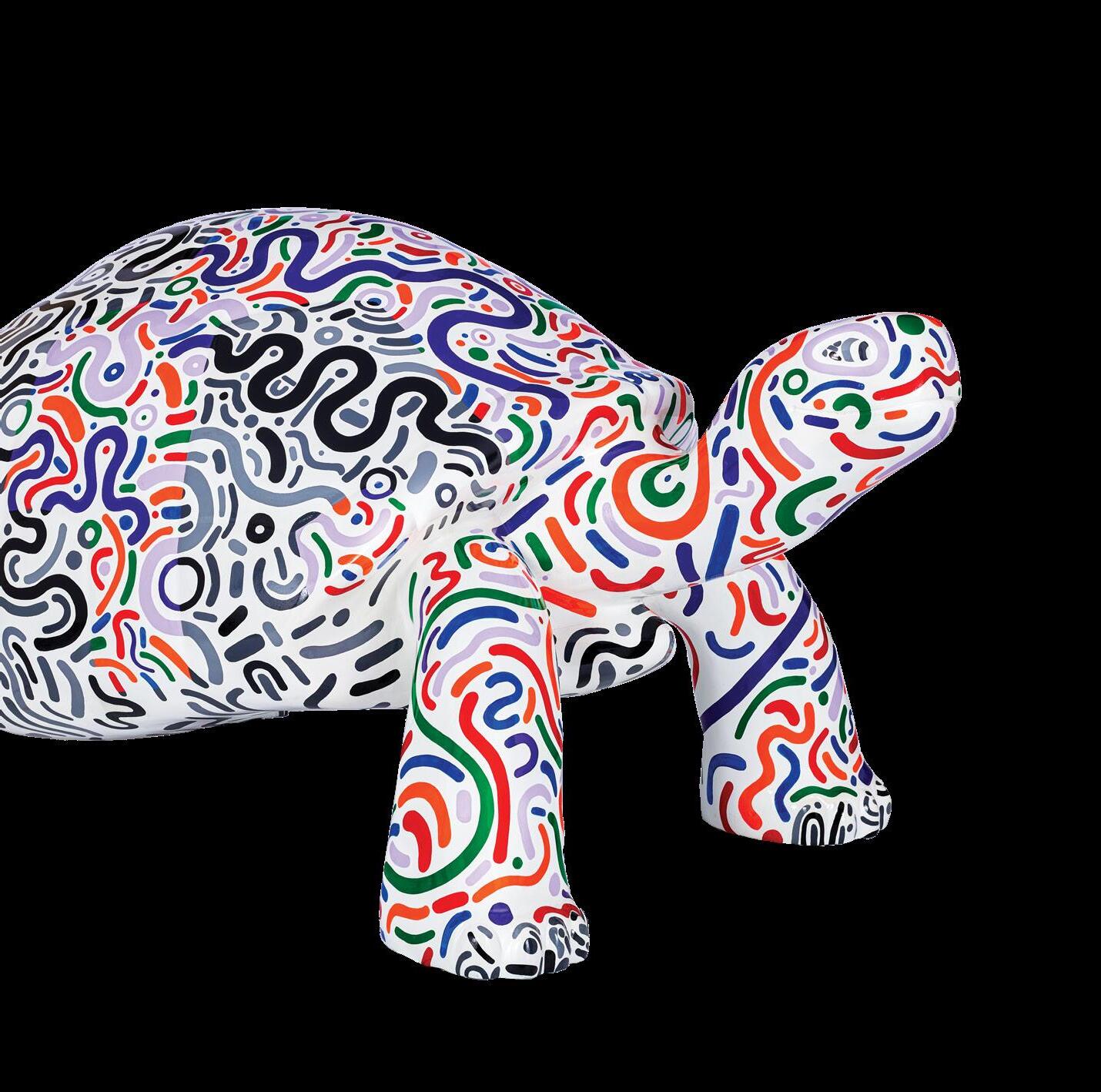

You can follow the trail by visiting our website tortoisetakeover.org
And follow us on Facebook, Twitter and Instagram @jerseytortoise
Sign up to bid at our exciting auction here tortoisetakeover.org/auction
Eat Jersey returned again this year at the Atlantic Hotel in Jersey. Since the inception of the food festival in 2015, we have been fortunate enough to be their philanthropic partner. Each year an auction of exclusive prizes and experiences is held. This year, over £11,000 was raised, adding to the almost £30,000 that they’ve raised across the years. We are so grateful to our longstanding partners at The Atlantic Hotel and we hugely appreciate the myriad of ways in which they support us.
At the end of 2022, we launched our latest fundraising campaign, Small but Mighty. This focussed on elusive, lesser-known animals, fondly referred to as “little brown jobs” by Gerald Durrell. These species form a vital part of Durrell’s rewilding strategy to build resilience and diversity into landscapes.
We would like to thank each and every one of you for donating to this campaign, together we raised an incredible £175,000
Dragonfish
In December 2022, Peter Wright and Steve Hayes, together known as team DragonFish Row, set off to take part in the Talisker Whiskey Atlantic Rowing Challenge.

After extreme weather, technical glitches, broken oars and flying fish attacks, they completed a 3,000-mile race known as the “world’s toughest row” across the Atlantic Ocean. Describing it as a “lifechanging” experience, on 5 February, they crossed the finish line and completed the race in 54 days 16 hours and 45 minutes.
The pair set off on the challenge with the ambition of raising as much money as possible for Durrell and Macmillan Jersey. We would like to say a huge thank you to Pete and Steve for taking on this gruelling task on behalf of Durrell and Macmillan Jersey. If you would like to donate to DragonFish, you can do so by visiting dragonfishrow.com
In the time of a declared global climate emergency, there has never been a more important time to think about the environmental impacts of our behaviour, particularly our consumption habits. At Durrell we aim to help drive the societal change needed to restore the natural world. The fashion industry alone, accounts for 10% of global greenhouse gas emissions. According to the Sustainable Fashion Forum, each year an estimated 100 billion garments are produced, of which 92 million tonnes end up in landfill. Buying second-hand clothes is a simple way we can help reduce this.
Shopping sustainably through the Durrell charity shop is a great way of keeping people’s preloved items in circulation and rehoming them to be loved by someone else; the epitome of “one man’s trash is another man’s treasure”.
Durrell charity shop
We opened our first charity shop in 2016, aiming to help people reduce their environmental impact and inspire positive thinking towards sustainable shopping. Fast forward to 2021 and we opened a newer, much bigger shop on-site at Jersey Zoo. The shop now has 560 square metres of retail space and 191 square metres of storage space for donations, with a designated drive-through for drop-offs. It was built as a low energy building and is powered using solar energy.
The shop adopts the principles of “Reuse, Recycle, Rewild” and sells an impressive collection of items, including clothing, accessories, shoes, toys, books, soft furnishings, kitchenware, and small furniture.
In addition to generous donations from our supporters, the shop also sells a selection of eco-friendly merchandise. The “Selected by Durrell” range features items made from recycled materials, products to encourage sustainable living choices, such as reusable water bottles, and pieces to encourage nature connection, such as bee houses. Our “Upcycled for Durrell” area showcases lovingly crafted items kindly donated by volunteers, staff, and supporters.
Where possible, the shop looks to help reduce any waste going to energy recovery. This includes looking for ways to sustainably dispose of items that cannot be sold. For example, heavily stained or damaged clothes are shipped to a textile recycling facility in the UK when possible. Here they are shredded and used for furniture stuffing, giving a new lease of life for these garments. Since our new charity shop opened in 2021, we have sold just shy of 600,000 items with over 25% of these items being women’s clothing.
We are passionate about selling pre-loved pieces, keeping them in circulation, reducing waste, and saving the planet one purchase at a time. All proceeds made from purchases generate vital funds for our global work to save endangered wildlife, revive precious landscapes, and reconnect people to nature.
Visit our shop and find out more
Our charity shop is open six days a week, from Tuesday to Sunday, 10am–4.30pm.
Visit www.durrell.org/charityshop to find out more about our charity shop, including the items the shop can accept and how you can get involved. You can also follow the shop on Facebook and Instagram by following @DurrellCharityShop.
We would like to say a huge thank you to everyone who donates their preloved items to us and to all of our wonderful volunteers, who give up their time to help us run the shop.

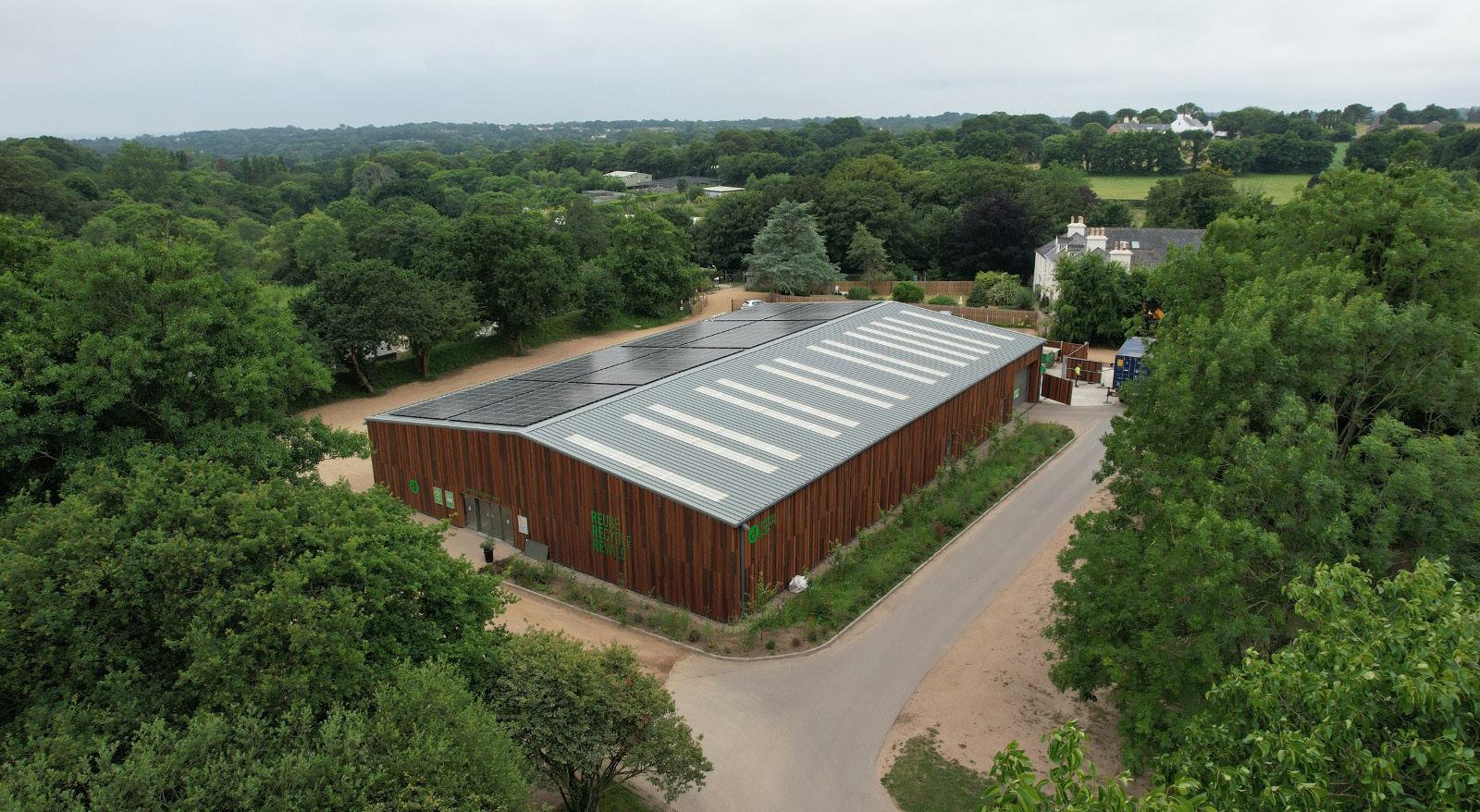


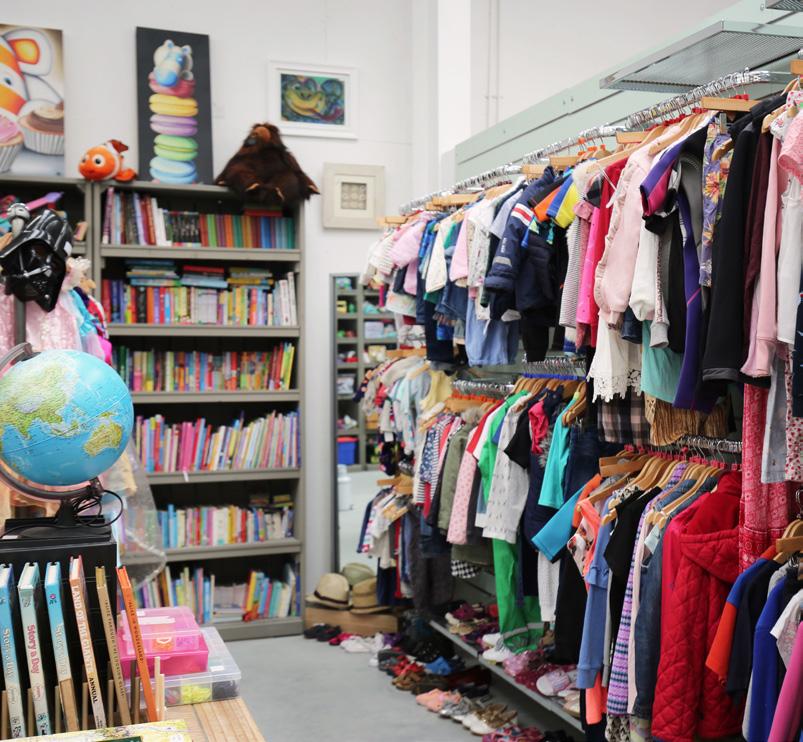
Ranger, Vallée de Mai, Praslin, Seychelles Islands Foundation, Seychelles
Rico is a Ranger for the Seychelles Islands Foundation, based at Vallée de Mai, Praslin, Seychelles. He has recently undertaken the DESMAN Endangered Species Management course, a 12-week training course based in Jersey. The course is designed to equip professionals with a range of conservation skills. He is the sixth member of the Seychelles Island Foundation to join as a Durrell DESMAN student.
What experiences first sparked your interest in wildlife? Growing up in the Seychelles, I was surrounded by nature and wildlife, which sparked my interest in conservation. I spent countless hours exploring the beaches and reefs, marvelling at the diversity of life surrounding me. During one of these explorations, I first encountered a pod of dolphins swimming and playing in crystalclear waters along with many other species. This experience left a lasting impression on me, and I knew from that moment on that I wanted to work to protect what’s left of this beautiful world. While volunteering for the Island Conservation Society, working on coral restoration, I developed a deep understanding of the complex relationships between species and the importance of protecting delicate ecosystems.
Tell us about your career path and how you got where you are today. After completing my high school education, I went to college to study fisheries science and joined the Island Conservation Society as a volunteer for work experience. I later volunteered for the Seychelles National Parks Authority and worked on Frégate Island as a conservationist. I specialised with the Seychelles magpie robin and other species, such as the giant Aldabra tortoise, sea birds, endemic reptiles and plants, and coral restoration work. I now happily work for the Seychelles Islands Foundation as a research Ranger at Vallée de Mai, Praslin.
What is your favourite animal that you work with, and why? The Seychelles black parrot. When I first saw one of these beautiful birds, I was captivated by their striking black feathers and unique vocalisations. As I work to protect the black parrot population and their habitat, I feel a deep sense of purpose and joy. I set out into the forest each day and listen carefully for their distinctive calls. When I spot black parrots high in the treetops, I can’t help but feel a sense of gratitude. I love working with them because they are unique and special creatures, found only in the Seychelles and nowhere else. I feel a deep responsibility to protect them and their habitat to ensure that future generations experience
the same awe and wonder I feel every day. Together, we are making a difference, helping to ensure that the black parrot and other rare and endangered species in Seychelles can thrive for decades to come.
Can you tell us more about the Seychelles Island Foundation and what you do there? The Seychelles Islands Foundation manages and conserves several island reserves in the Seychelles, including the Aldabra Atoll, island home of the Aldabra giant tortoises, and Vallée de Mai. At Vallée de Mai, I am responsible for various things, including database maintenance, monitoring flora and fauna, such as black parrots and coco-de-mer plants, and taking part in invasive species removal, such as the yellow crazy ant.
Why did you apply for the DESMAN course, and what do you hope to gain from the experience? I first heard about Durrell and the DESMAN course through my colleagues at work who had taken the course previously. The skills the course offers, such as species management and practical conservation techniques, particularly interested me. The conservation standards and managing invasive species skills will be very useful for my career. I hope to gain a better understanding of using habitat restoration techniques, which involves identifying areas that have been degraded or damaged and working to restore them to their natural state. I hope to do some conservation with Durrell someday. This was truly a great opportunity to gain hands-on experience and learn from other conservationists. The skills I’ve learnt on the DESMAN course will help me to better manage and conserve the species and habitats I work with.
What are your hopes future conservation of Seychelles? My hope for the future of conservation in the Seychelles is that we can continue to protect our unique biodiversity for future generations. This will require collaboration between conservation organisations, government agencies, and local communities to promote sustainable development and ensure the longterm conservation of our natural heritage.




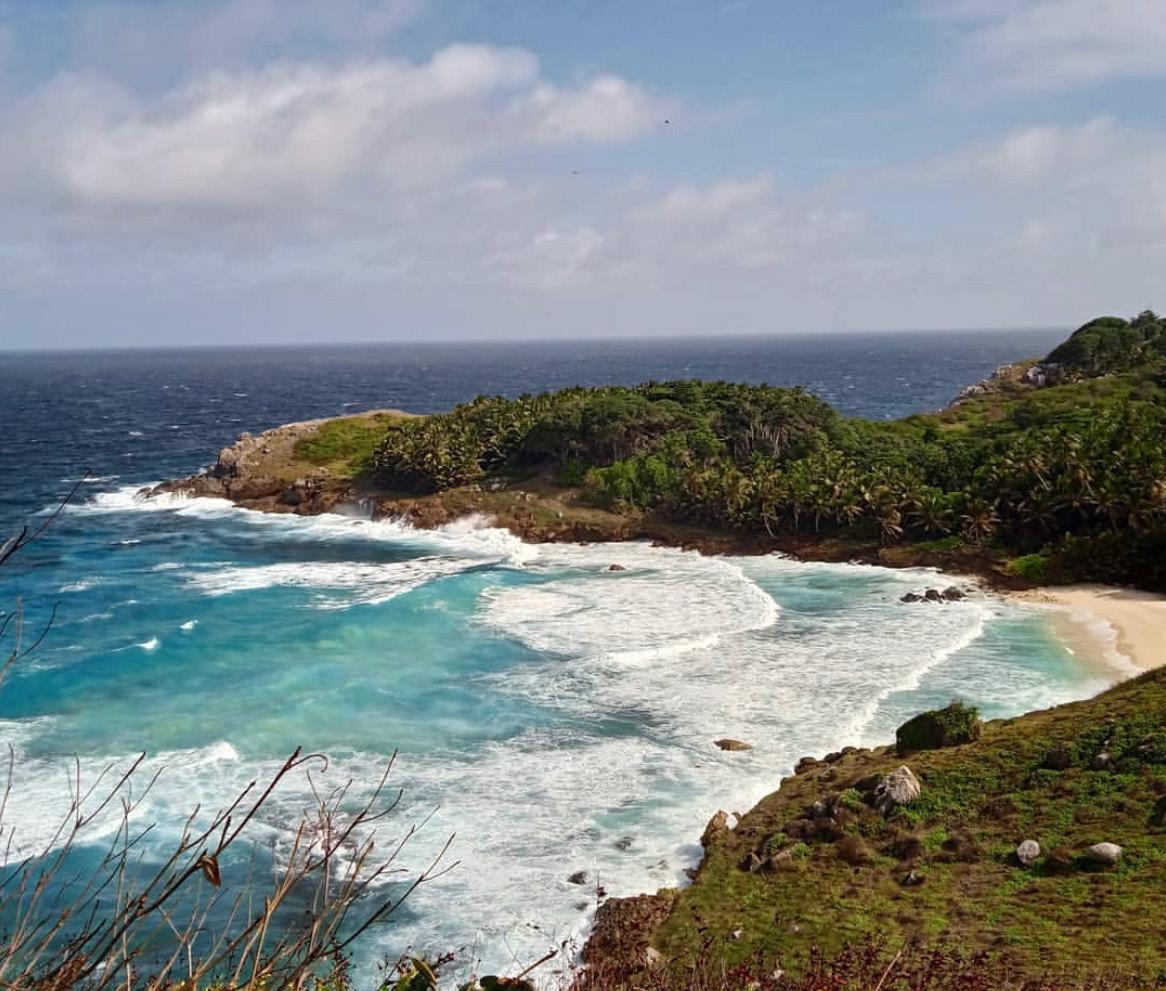

Dr Izabela Barata, SAFE Programme Coordinator, surveying rare frogs under the Milky Way, in Brazil.
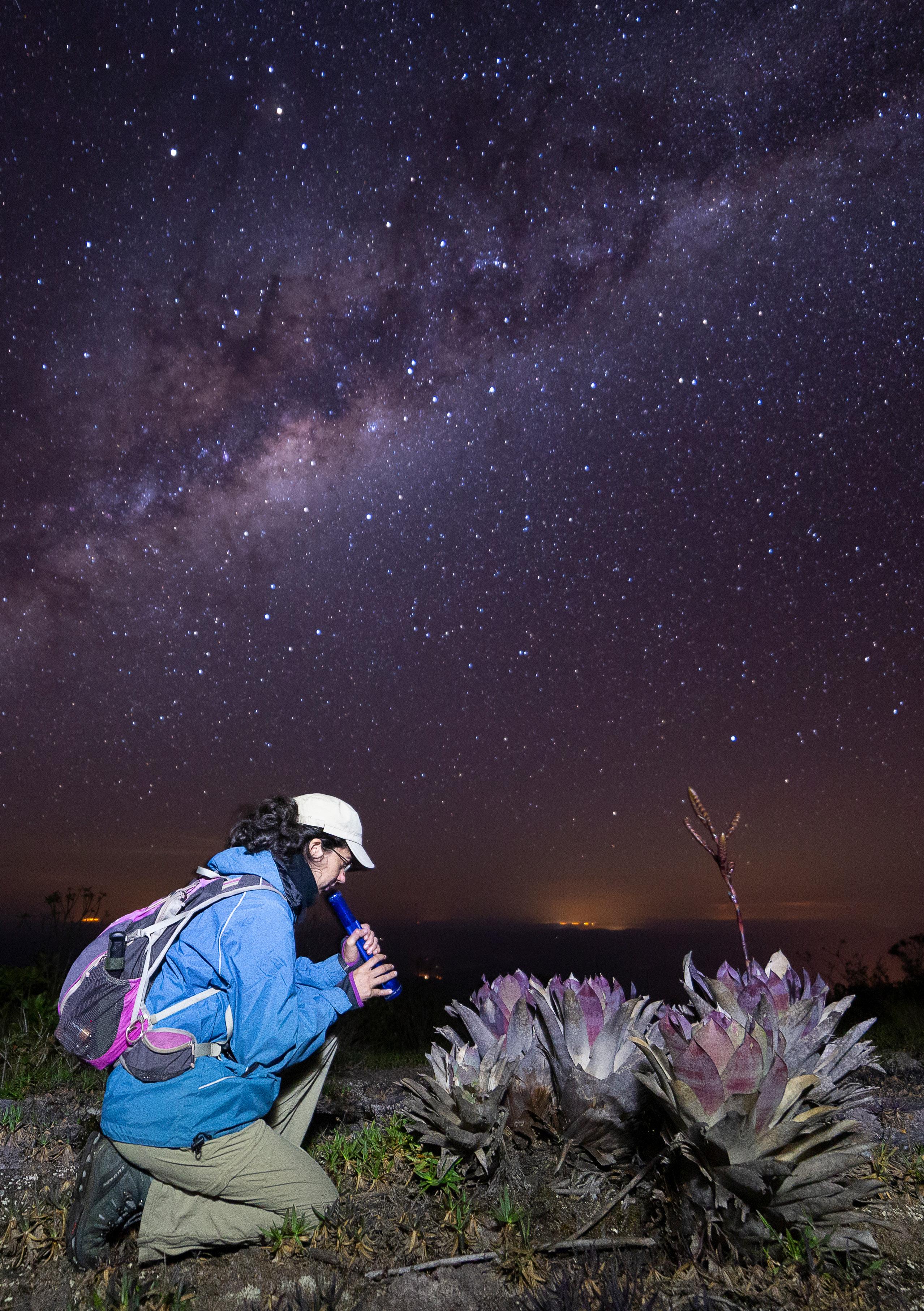

There is no first world and third world. There is only one world, for all of us to live and delight in


